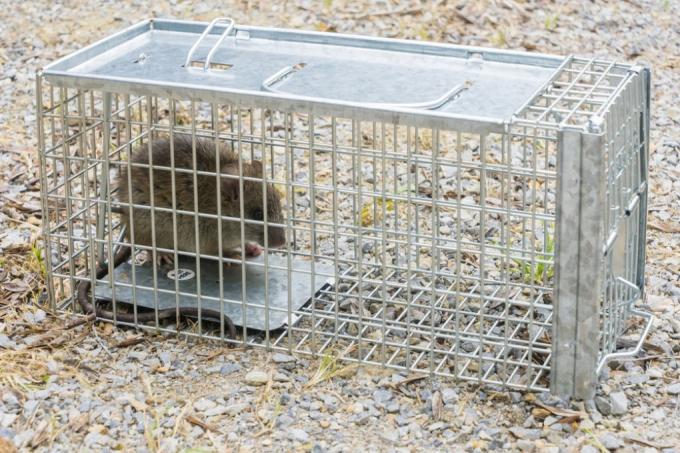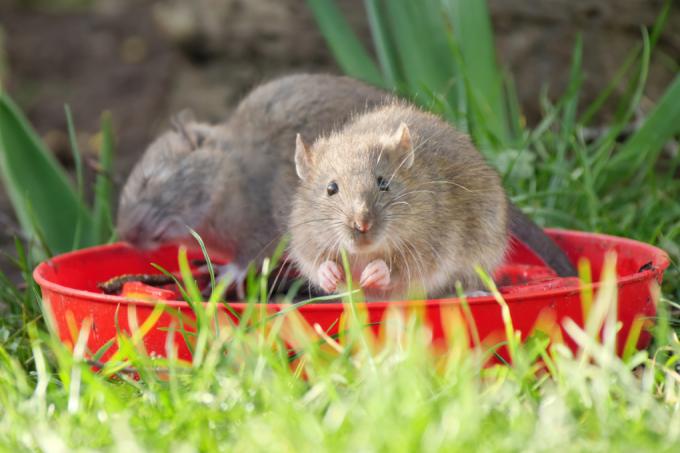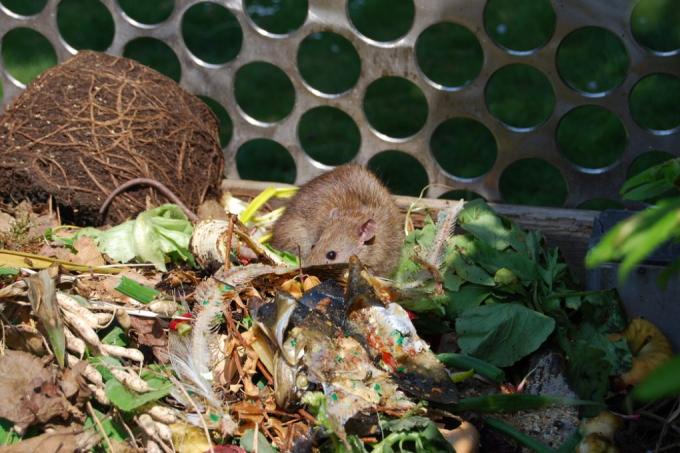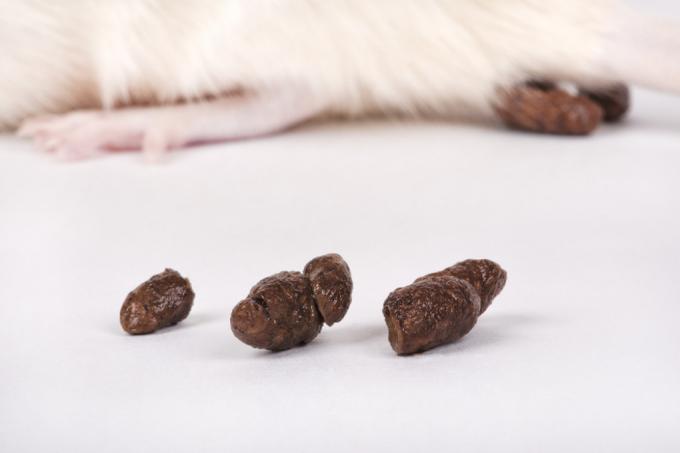AT A GLANCE
What types of rats are there in Germany?
Brown rats (Rattus norvegicus) and black rats (Rattus rattus) are common in Germany. Brown rats are larger, more competitive and more widespread, while black rats are an endangered species. Pet rats, derived from brown rats, are popular as pets and are characterized by numerous color variations.
- Rat species in Germany are the brown rat or sewer rat (Rattus norvegicus) and the house rat or ship rat (Rattus rattus).
- Brown rats are larger, more competitive, and widespread. House rats are threatened with extinction.
- Pet rats are popular pets and descended from brown rats.
Large rat species list - facts at a glance
Strictly speaking, there are only two types of rats that teach us to fear in Germany. The short list is completed by peace-loving, harmless pet rats, which inspire with drawings and colors worth seeing. The following list and pictures illustrate outstanding differences between the wild, large rat species and domesticated pet rats that have been pimped up by breeding:
also read
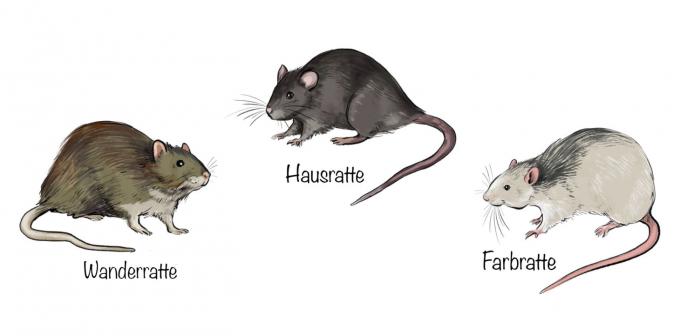
| rat species | brown rats | house rats | pet rats |
|---|---|---|---|
| head torso length | 18-26cm | 17-22cm | 22-26cm |
| tail length | 14-21cm | 18-23cm | 18-22cm |
| Overall length | 32-47cm | 35-45cm | 40-48cm |
| coat color | brown-grey to brown-black | dark brown to black | numerous colors |
| Weight | 350-550g | 160-210g | 200-500g |
| habitat | sewerage | Building | Cage |
| food preference | grain, waste | fruits, vegetable food | dry food, fruits, vegetables |
| Scientific name | Rattus norvegicus | Rattus rattus | Rattus norvegicus forma domestica |
| common name | sewer rat | ship rat | lab rat |
Has the compact list of facts aroused your interest in more detailed information on rat species in Germany? Then please read on. Brief, revealing portraits push aside the sober curtain of facts. Individual characteristics and lifestyles come to light that make each rat species unmistakable.
Brown rat on the rise - characteristics and way of life

Brown rats actually like to hike
early 18th At the end of the 19th century, the brown rat caught the travel bug and made its way west from Southeast Asia. Russia was the gateway to Germany for the wandering rodents. Here omnivores with a penchant for dark, damp conditions found everything a rat's heart desires. Brown rats are smart, trainable and very social. The rodents live in packs of up to 60 animals that recognize each other by smell. A territory is defended against foreign invaders with combined forces. The following overview summarizes what characterizes the large rat species in Germany:
- omnivore: discarded food, grains, nuts, paper, soap, fur, leather, birds, fish, eggs, worms
- Flexible activity: mainly crepuscular and nocturnal, also diurnal in the absence of humans
- Highly Evolved Senses: excellent sense of smell, touch and hearing, vibrissae and guard hairs all over the body
- resistance-active: rapid development of resistance to numerous rat poisons
In particular, rats are hosts and excretors of up to 120 serious pathogens. These include tapeworms, cholera, dysentery, toxoplasmosis, tuberculosis, hepatitis and the dreaded hantavirus.
Explosive spread
Underground sewage systems are brown rats' sanctuary, to which their middle name, sewer rat, aptly refers. The beasts also love rubbish dumps, ruined buildings, junk and dense bushes. As long as a shelter provides adequate food, it is not safe from ravenous rats. The explosive spread is promoted by striking biological properties.
Rats can slim down surprisingly. Where the rat's head fits through, the whole brown rat always fits through. Sewer rats can actually go anywhere, because they are good climbers, excellent diggers, persistent swimmers and dives. They master three days of non-stop swimming just as easily as holding their breath for three minutes.
An exorbitant propagation rate makes a significant contribution to the widespread spread in Germany. In the herd, the females are fertile and pregnant at the same time. Six to eight baby rats see the light of day per litter and female. The offspring are independent within three weeks and sexually mature after three months. This results in frightening propagation rates. A female produces up to 500 children and grandchildren per year. Experts have calculated a theoretical number of offspring of almost 2000 animals per female and year. The only limiting factors are lack of food and targeted control measures.
A click on the video below gives an amazing insight into the secret world of brown rats.
House rat in retreat - characteristics and way of life
For more than 2000 years, the black rat has been making life difficult for people in Germany. In direct comparison, black rats are a little narrower and lighter than stocky brown rats. Black rats have a more pointed snout, larger ears and eyes, and a longer tail than sewer rats. More striking differences emerge with regard to the preferred residential area and preferred way of life.
House rats prefer to have a roof over their heads, preferably in the immediate vicinity of people and their food supplies. A warm, dry place in the attic, in partition walls or in the basement is entirely to their liking. The rodents love to climb and are not afraid of a slippery supply pipe. Outside, the fur wearers are rarely found. At rats in the garden mostly wandering rats. In any case, sightings of black rats in Germany are now a rarity and for understandable reasons.
With the invasion of brown rats in Germany, the fate of black rats was sealed. Today, the more robust sewer rats have massively displaced the black rat population. The black rat is on the red list of endangered species in most federal states. Since attics have been converted into living space and no longer serve as storage space, the habitat of black rats has been shrinking, which also plays into the hands of successful brown rats.
digression
Identify rat species by their droppings
The best pictures of wild rat species in Germany often turn out to be a dead end for the identification service, because the nocturnal, shy rodents never show up. Most of the time it is just excrement that you see in the house and garden from rats that have settled in. shape, color and size of rat feces are meaningful indications for an accurate distinction between the two large rat species. Brown rats droppings are black, 1.5-3 cm long, spindle- or cone-shaped with blunt ends. Black rat droppings brown to dark brown, 0.5 to 1.5 cm long and narrow, banana-shaped with comparatively pointed ends.
Pet Rats - lovely species of rats to have as pets

Pet rats are the pets among rats
Pet rats have shaken off a reputation as a dangerous pest. Their direct descent from the brown rat can hardly be seen in the breeding beauties. Breeding-modified laboratory rats inspire with picturesque coat markings, gentle disposition, loyal attachment and can be trained without any problems. Furthermore, the cute rodents have no pathogens in their luggage. Breeds worth seeing make pet rats popular and coveted pets. The following list gives an insight into the most beautiful drawings and colors:
Artistic drawings
The modern pet rat is light years away from the dirty gray fur uniform of wild brown rats. Since the beginning of targeted rat breeding at the beginning of the 20th At the beginning of the 20th century, premium breeds boast artistic markings that leave nothing to be desired. The following variations are also certified by experts that the beauty is not at the expense of animal welfare:
- blazed: white blaze on forehead
- bareback: colored are head, neck, shoulders and chest
- Hooded: Colored head and shoulders, back stripe continuous to the base of the tail
- husky: white blaze on the face up to the neck, colored back stripe, possibly colored flanks
- Irish: white patch on chest
- Variegated: colored head, variegated body on upper and lower surface
Fancy colors
Parallel to aesthetic, species-appropriate drawings, pet rats live up to their name with these popular colors:
- agouti: Grey-brown wild colour, each individual hair darker at the tip and lighter towards the body
- cinnamon: light brown to cinnamon in various markings
- Pearl: bright silver
- Siam: beige base tone, dark nose, ears, legs and tail, similar to a Siamese cat
- topaz: golden-orange coloring
Not to be forgotten are albino pet rats, who do without any color pigmentation and markings. Anyone wanting solid color rat species for pets should look out for self or solid color rats that come in all black, cream, English blue, or coffee brown.
Tip
The really large rat species live in tropical regions. In 2007, for example, a giant rat was discovered in New Guinea with an impressive size of 82 centimeters and a furious weight of 1500 grams. African giant hamster rats (Cricetomys) think: "There's still room for improvement" and reach a length of up to 90 centimeters and a heavy weight of 2500 grams.
frequently asked Questions
Why is the muskrat missing from the list of rat species in Germany?
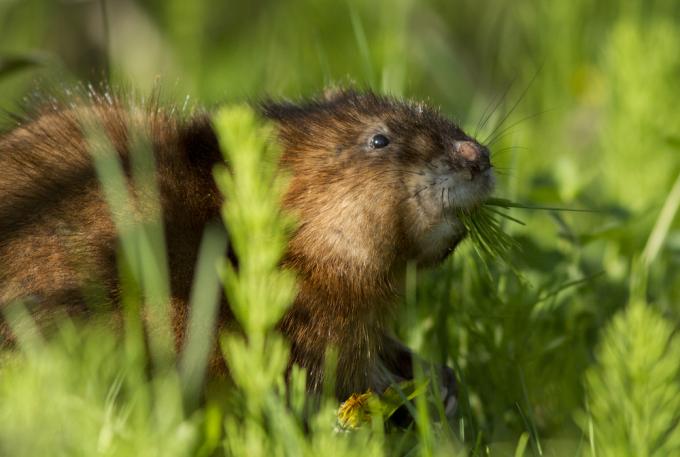
Despite its name, the muskrat is actually not a rat at all
With a stocky build, dark fur color and long tail, the muskrat (Ondatra zibethicus) looks confusingly similar to a large brown rat. From a zoological point of view, however, it is not a rat but a vole. Muskrats live mainly in running and still waters, feed on reeds and riparian plants, avoid proximity to humans and are not disease carriers.
What species of rats are there worldwide?
The rat genus is assigned 66 species worldwide, divided into 6 groups. The norvegicus group includes the rat species brown rat, Himalayan rat and Central Asian rat. In the exulans group, the Pacific rat is listed. The extensive rattus group includes, among others, house rats, paddy field rats and the widespread Asian house rats. Rat species primarily native to Australia are listed in the fuscipus group. Grouped together in the leucopus group are rat species living on New Guinea and neighboring islands. Rat species endemic to Sulawesi and adjacent islands are registered in the leucopus group.
How many rats are there in Germany?
In the absence of official rat statistics, various estimates are circulating. The numbers vary between one and four rats per inhabitant. In the worst case, there are 350 million rats in Germany. Of these, around 95 percent are brown rats and 5 percent are house rats. There are also pet rats that are kept as pets.
Tip
The two large rat species in Germany are dangerous disease carriers. According to the Infection Protection Act, rat infestation is in Garden and house registration. For property owners, the sighting of a single brown rat or black rat means Property managers and tenants have a legal obligation to report, non-compliance with which is considered an administrative offence will be punished.

